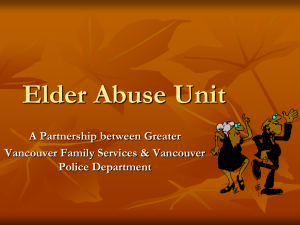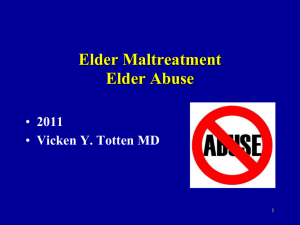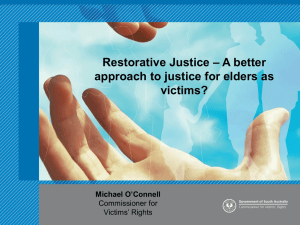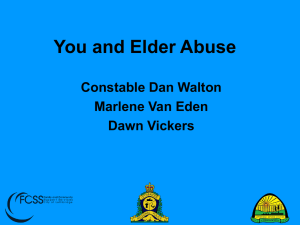Elder Abuse
advertisement
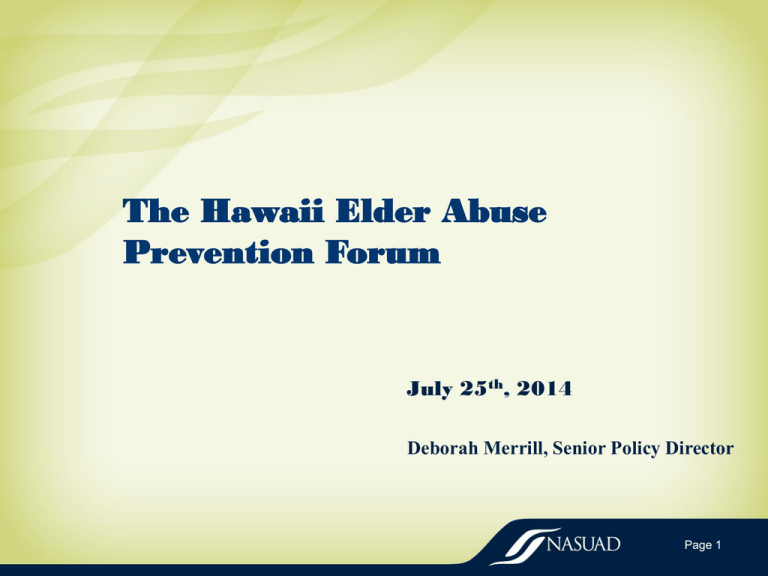
The Hawaii Elder Abuse Prevention Forum July 25th, 2014 Deborah Merrill, Senior Policy Director Page 1 introduction & objectives Page 2 What do people know? • Violence against animals • Violence against children • Domestic Violence • Elder Abuse Page 3 Learning Objectives • Define and distinguish elder abuse and related phenomenon (e.g. self-neglect and abuse in later life) • Describe older victims, their abusers and the impact of elder abuse on them • Determine what agencies to prevent Elder Abuse • Identify strategies to respond to possible elder abuse situations Page 4 Today we are using: A broad definition of Abuse *Abuse – including physical, sexual, psychological, *Neglect – including by self and others *Exploitation – including financial and property Page 5 Growth in Elderly population From 1990 – Population 65 and older at 30 million In 2050 – Population 65 and older at 88 million Page 6 Stories Elder Abuse is an iceberg. Reported estimates use the number 10% Page 7 Elder Abuse: Under the Radar A 2011 study in New York State found that for every one case of elder abuse that comes to the attention of a responsible entity… Another twenty three point five cases never come to light 1 discovered vs. 23.5 hidden Elder Abuse robs an older person of their independence. Their life is never the same. Page 8 Elder Abuse • Physical, sexual, or psychological abuse, as well as neglect, abandonment and financial exploitation of an older person by another person or entity • That occurs in any setting (e.g. home, community, or facility), • Either – In a relationship where there is an expectation of trust; and/or – When an older person is targeted based on age or disability Page 9 Related Phenomena • Abuse in Later Life (term often used by domestic violence and sexual assault advocates (50+) • Abuse of vulnerable adults (some statutes/APS – adults aged 18+) • All crimes against persons age 60 and older (criminal justice) • Self-neglect Page 10 Hawaii state laws??? Who are mandatory reporters? What is the state definition? Page 11 Polyvictimization: Multiple forms of elder abuse often occur at the same time. Page 12 Discomfort in Disclosure • Shame • Fear • Embarrassment • Grief Page 13 Who are the older victims of abuse? • All races, religions, ethnicities, cultures and socio-economic groups- commonality that they are older and victims • Both men and women, more women are victims of intimate partner violence • Persons who are socially isolated, age is a contributing factor • Healthy, active • Needing care and with cognitive impairment • In private homes, congregate living arrangements, and facilities Page 14 • Who are the Abusers? Page 15 Abusers • Most older victims are abused by someone they know and trust or would expect to trust • Family members • Spouses or partners • Caregivers (family, paid staff or volunteers) • Persons in positions of trust/authority( powers of attorney, guardians, faith leaders) • Some target older adults for their age and perceived or real frailty • Strangers Page 16 Victims Living in Facilities are Abused by: • • • • • Caregivers and other facility staff and volunteers Other residents Spouses and partners Family members Strangers Page 17 Victims of abuse are never the same. Page 18 Effects of Elder Abuse on Victims • Mortality: Up to 300% higher mortality rates than non-abused older people • Distress: Significantly higher levels of psychological distress and lower perceived self-efficacy than other older adults • Health: Bone or joint problems, digestive problems, depression or anxiety, chronic pain, high blood pressure and heart problems Page 19 Complex Dynamics • No single dynamic explains elder abuse • “Depending on the victim-offender relationship and the type of elder abuse, elder abuse may resemble domestic violence, child abuse, or fraud or the phenomenon can stand on its own with the complexity of the relationships, individual vulnerabilities and contexts in which it occurs.” Page 20 Victims Want the Abuse to End But often maintain a relationship with or protect the abuser because: • Fear (of retaliation, death, facility placement, or loss) • Love/care about the abuser (especially an adult child) • Economic reasons • Health concerns Page 21 What can you do? • Listen to older adult • Do not assume cognitive impairment • What do you do in your work? • What is Hawaii doing now? Page 22 Contact information: Deborah Merrill Senior Policy Director NASUAD 202.898.2578 x 122 Dmerrill@nasuad.org Page 23 For more information, please visit: www.nasuad.org Or call us at: 202-898-2583




